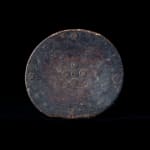Baga Polychrome Caryatid Stool, 20th Century CE
Wood and Mixed Media
40.6 x 54 cm
16 x 21 1/4 in
16 x 21 1/4 in
PF.4802 (LSO)
This large and strongly-rendered stool is superficially reminiscent of the Luba, who are famed for their caryatid seats. Yet the size, vivid colour and characteristics of the fac enad coiffure...
This large and strongly-rendered stool is superficially reminiscent of the Luba, who are famed for their caryatid seats. Yet the size, vivid colour and characteristics of the fac enad coiffure all suggest that it was in fact made by the Baga group of Guinea Bissau. Stools of this sort are always associated with social elites. The structure is traditional, with a kneeling woman separating the base and the seat itself. The body is short and squat, with short legs and comparatively elongated arms that are holding up the seat. She is clad in a skirt/loincloth, strapping crossing the chest from both directions, a pair of bangles on each wrist, and a necklace with three pendants. The body is painted in vivid red, the eyes highlighted in black and white. The hair is a series of crests, with an ornate band across the forehead.
The Baga are one of several groups of coastal Guinea Bissau, and live in village environments traditionally ruled over by clan heads. Their traditional religion was forced out by the arrival of Islam in the mid 20th century, leading to a plethora of art objects arriving in western markets. Perhaps the best-known is the large four-legged Nimba mask, which is associated with fertility of both crops and women, while various smaller figures, drums and head-crests are also known. Seats such as this were prestige objects which were used by elders during secret meetings.
Dating is ambiguous, but the presence of coins from the 1920s, nailed to the surface of the seat, may provide an indication. This is a well-rendered and even usable piece of African art.
The Baga are one of several groups of coastal Guinea Bissau, and live in village environments traditionally ruled over by clan heads. Their traditional religion was forced out by the arrival of Islam in the mid 20th century, leading to a plethora of art objects arriving in western markets. Perhaps the best-known is the large four-legged Nimba mask, which is associated with fertility of both crops and women, while various smaller figures, drums and head-crests are also known. Seats such as this were prestige objects which were used by elders during secret meetings.
Dating is ambiguous, but the presence of coins from the 1920s, nailed to the surface of the seat, may provide an indication. This is a well-rendered and even usable piece of African art.
Literature
V28



